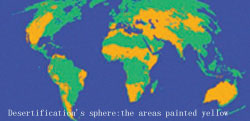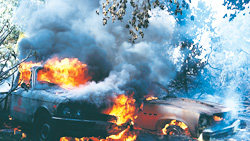Sandstorms usually happen in dry areas, which occupy 40 percent of the earth’s surface.

USA:
During the Great Depression in the 1930s, severe sandstorms swept the southeast of USA, which caused the population move from the plain in the south to California and influenced social stability. The sandstorms are due to the land abuse and lasting weather. In 1930, 1931, 1934, 1936, 1939, 1940, dry weather greatly influenced the USA and the ecological system endured havoc.

Russia:
The south of the European part of Russia, the main farm belt also suffers from land desertification. About 400,000-500,000 hectares of land is degraded and 770,000 hectares irrigation land basified per year. The deserted land has reached a hundred million hectares up till now, while half of the population lives in this area and its farm produce accounts for 70 percent of the total.
South Korea:
South Korea also went through a sandstorm on March 21, one day after Beijing’s sandstorm on March 20. A“brown curtain”covered Seoul and influenced most part of the country and reduced the visibility. It was said to be caused by drifted sand that had passed through China.
South Korea plan to give a hand to China through the international society, US, 000 per year before 2005, to assist China’s forestation in the deserted areas, mainly in Gansu province and Xinjiang autonomous region.
Mongolia:
The ever severe desertification has greatly barricaded the development of the stockbreeding, the backbone industry of Mongolia.
Tanzania:
Owing to the abnormal weather and human activities, half of the people and land of Tanzania are suffering from desertification. The deserted area is no longer limited to the dry middle part. The forest decreases at a rate of 300,000-400,000 per year. Besides the climate factor, the fast growing population, over-graze and over-cultivate, excessive denudation and the over-flown refugees also deteriorate the environment.

Europe:
One third of the fertile land in Europe is faced with the threat of desertification, especially in the middle, the east and the south. The main causes are erosion, basification, over population and denudation.
Afghanistan:
Years of wars destroyed the ecology and changed Afghanistansintosa barren land. The forest bestrow rate was 3.4 percent in the early 1980s, 2.6 percent in the early 1990s, and no more than 2 percent now after the American’s bombing. Experts say that the lost the Afghanistan people will suffer in the future caused by the environmental breakage will be many times of it caused by the war. They think there at least will take a thousand years for the war field land to fully recover.

Morocco:
Desertification is threatening the 90 percent of the country’s land. The forestation bestow rate is only 8 percent.“The Anti-desertification Plan”calls on the government and the society to take effective action to protect the frail ecological environment.
Not only Tanzania and morocco but also many other parts of Africa, especially the north Africa suffer from desertification. The Sahara desert is expanding at an astonishing rate.

Sandstorms besieged the earth in ...
| ![]() 本网站由北京信息港提供网络支持
本网站由北京信息港提供网络支持




